
| Home |
| Glossary |
| Lobstering |
| Some Facts |
| Handling Gear |
| Wildlife |
| Tools |
| A Day at Sea |
| The Boat |
| Lobsters |
| Facts |
| Molting |
| Eggers |
| Oversized |
| The Sea |
| About Tides |
| Misc |
| Credits |
| Site Policy |
| The Author |
| Today's Hi/Lo Tides |
11/13/25
05:40 8.303 H
11:38 1.274 L
17:58 8.656 H
Station: Fort Point, NH
Station-local tide times. Height in Feet (MLLW).
Data are predictions supplied by the NOAA Tidal Predictions
Web Service.
Last updated:
11/13/25 05:59 UTC |
About Lobsters

General lobster anatomy.

A female. |

A female. |
Lobster blood is a clear fluid. When the animal is boiled, the blood turns to an opaque whitish gel. It has no discernible flavor and is perfectly safe to eat. If a wounded lobster is hauled to the surface, it may start to bleed. Returning it to the sea bottom is the best recourse since the water pressure will help stop the bleeding. If the animal is of legal size, it can be placed back in the trap and the trap reset, to be hauled again at a later date. |
|
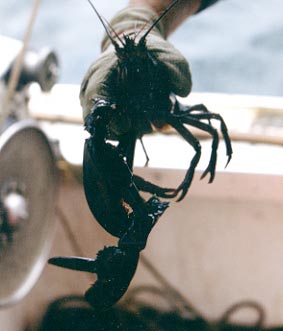
This animal was taken from the trap still holding one of its own claws that it appears to have removed itself. In over 20 years of fishing, the captain said he's only seen this three times.
Lobsters can regenerate legs, claws, and antennae. In fact they can amputate their own claws and legs (autotomy) to escape danger. The term 'amputate' can be in the passive sense as well. I've seen a lobster spontaneously drop a claw for no apparent reason.
Berried females carry thousands of eggs attached to their swimmerets. Depending on water temperatures, the eggs will remain attached for about a year on average. Only .1% of the eggs will make it over six weeks after being dropped.
Lobsters molt (shed their shells) to grow. They secrete enzymes that soften the shell and connective shell joints. The shell splits up the back and the creature backs out leaving it behind...including the membrane that covered the eyes. They will increase their size by about 20% at every molt. By the time a lobster is of legal size, it will have molted about 20-25 times, averaging 4-5 molts a year. After a molt the animal is vulnerable because the new shell is very soft. It will hide among the rocks on the bottom for 6-8 weeks until its shell hardens enough to offer some protection.
Lobster larva will molt about six times while still in the egg. After they are released from the mother's swimmerettes and hatch, the larva will float freely in the water column and molt several more times before taking the form that we recognize as a lobster. At this point they may be only 1/4" in length.
Lobsters exhibit 'handedness' . Some animals will have the crusher claw on the right side while others will have it on the left.
Lobsters may come in a variety of colors besides the usual blue-green, including blue, yellow, red, and white. Some even come in two colors, having half of their shell one color and the other half a totally different color. Of these only the white ones (true albinos) don't turn red when cooked.
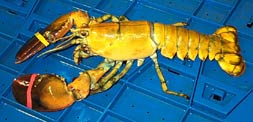
Just about as yellow as a lobster can get. 
Here's one in blue (photo courtesy of D. Cowan). |

Phil hauled this one in July '09. It's 100% blue. He actually caught it twice. The first time he threw it back because it's a short. The second time he called for permission to take it. It now lives with the Joker in Booth Bay. |

The Joker. The odd thing about this animal is that the cephalothorax is all one [natural] color while the rest of the animal is symmetrically different. Even its mouth parts were normal-colored on the right, and orange on the left. He now lives at Maine State Aquarium in Booth Bay. |
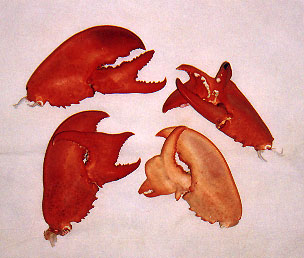
Claw chaos. These claws were collected over the last three years. This kind of deformity has been recorded as far back as the 1800's. Pictures don't do these justice. Unless you can turn them around in your hand, you can't fully appreciate the wierd morphology (the one at the upper right, particularly). |
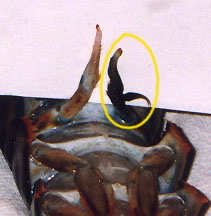
The left (circled) gonoped of this male is severely deformed. Animals displaying this condition emerged in 1998. In over 25 years taking lobster, the captain has never seen it before. It's cause is a matter of speculation. Even early in the 1999 season, animals have been found with this deformity. |
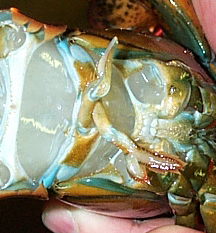
This animal looks like its half male, half female. |
Among other things, lobsters eat crabs, sea stars, sea urchins. They are not by nature cannibalistic, except when held in crowded conditions (traps, pounds, etc.). Even with banded claws, it's still not unusual to find partially eaten animals in the live-tank when it's emptied.
The nervous system of a lobster is decentralized and has been likened to that of a grasshopper.
One lobster caught just off shore was released and recaught by the same fisherman 24 hours later - and 3 nautical miles out at sea!
Diane Cowan has been studying and tagging baby lobster that hide under rocks in shallow water along the shore during very low tides. Be sure to check out her site at the The Lobster Conservancy.
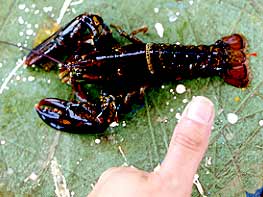
A cute little nipper. This guy was so small he fell out of the trap through the bars. He'll still get your attention if he bites you.